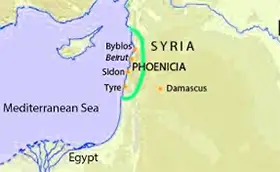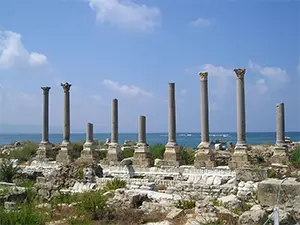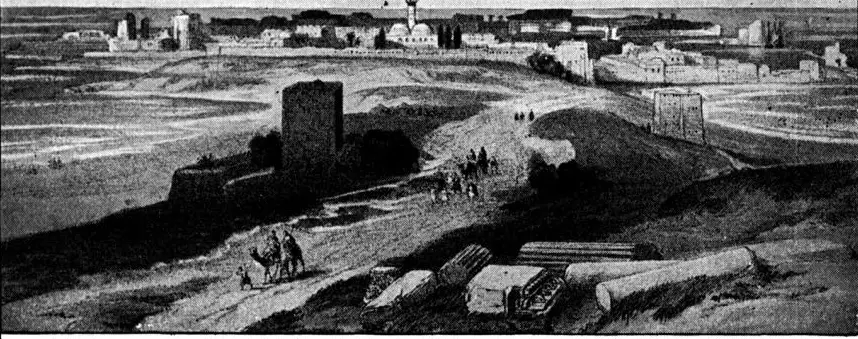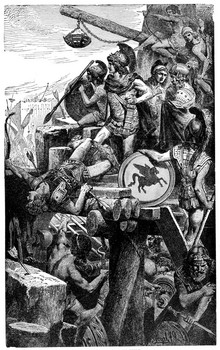Ancient Tyre
Tyre was one of the oldest and most prominent cities in the ancient Phoenician culture. Dating to 2750 B.C., it was originally two cities, one on the eastern coast of the Mediterranean Sea and the other on an island a half mile off that coast. The continental city was known as Ushu, Paleotyre, and Old Tyre. Many sources say that people from Sidon settled Tyre. 
Tyre was a friend of Ancient Egypt, particularly during the Eighteenth Dynasty. A number of the Amarna Letters are to and from the leaders of Egypt and Tyre. Some of those letters are from Abimilku, the head of Tyre, to the then-pharaoh Akhenaten. Tyre has links to the Ancient Israelites. The Tyrian king Hiram I, who first ruled in 969 B.C., sent a It was Hiram I as well, along with his father, Abibaal, who declared that Tyre had a supreme god, named Melqart. (Previously, the city residents had worshiped the prime couple of Astarte and Baal.) As well, the kings assumed control of the temple treasury, taking power away from the priests. In addition to the famed wood that Tyrian traders shipped to its neighboring civilizations, the city was known for its purple dye, made from Murex shellfish. The color became known as Tyrian purple and was the preferred color of royalty for clothing. Like many other Middle Eastern civilizations during this time, Tyre came under the sway of the Assyrians, who demanded tribute in exchange for "peace." A series of Assyrian kings besieged Tyre during the 8th and 7th Centuries B.C., with varying results. Shalmaneser V 724–720 B.C.), Sennacherib (701 B.C.), Esarhaddon (671 B.C.), and Ashurbanipal (663 B.C.) tried without success, as did the famous Babylonian leader Nebuchadnezzar II, whose siege lasted 13 years. It wasn't until the Persian king Cyrus the Great that a foreign leader succeeded in conquering Tyre. Cyrus and the Persians arrived in 539 B.C. and took the city. The Persians maintained control of the previously impregnable city for two centuries. One exception to this was an occupation by Evagoras, prince of Cyprus, from 392 B.C. to 382 B.C. Persia regained control after that. The people of Tyre organized a series of other revolts against Persian rule, but Persian rule held firm, until the arrival of Alexander the Great in 332 B.C. Alexander had marched his men along the Mediterranean coast, seizing cities on the Phoenician coast. One of his main targets was Sidon, the port city that served as the shipyards for the Persian invasions of Egypt and Greece. In 351 B.C., the people of Sidon locked their gates and set fire to the city rather than submit to the Persian leader Artaxerxes. This, of course, made it easer for Alexander to conquer. With all of the other major settlements in the fold, Alexander now had one major obstacle left to his goal of ruling the entire eastern Mediterranean: Tyre. 
Two of Alexander's successors, Seleucus I and Ptolemy I vied for control of Tyre for a time. In 126 B.C., when Tyre was again its own master. During this period, Tyre had given aid to Carthage during the Punic Wars and provided refuge for Hannibal for a time. The forces of Roman arrived on the scene in a big way in the 1st Century B.C. Other areas surrounding Tyre became a Roman province. Tyre, however, kept its status as an independent city. |
|
Social Studies for Kids
copyright 2002–2024
David White



 contingent of men and materials to help King Solomon's people build the First Temple in Jerusalem; one of the things contributed were the famed Cedars of Lebanon. The people of Tyre and the people of ancient Israel enjoyed trade agreements during the reigns of both Solomon and his father, King David.
contingent of men and materials to help King Solomon's people build the First Temple in Jerusalem; one of the things contributed were the famed Cedars of Lebanon. The people of Tyre and the people of ancient Israel enjoyed trade agreements during the reigns of both Solomon and his father, King David.
 the bridge and killed several of Alexander's men but only hardened his resolve.
the bridge and killed several of Alexander's men but only hardened his resolve.
